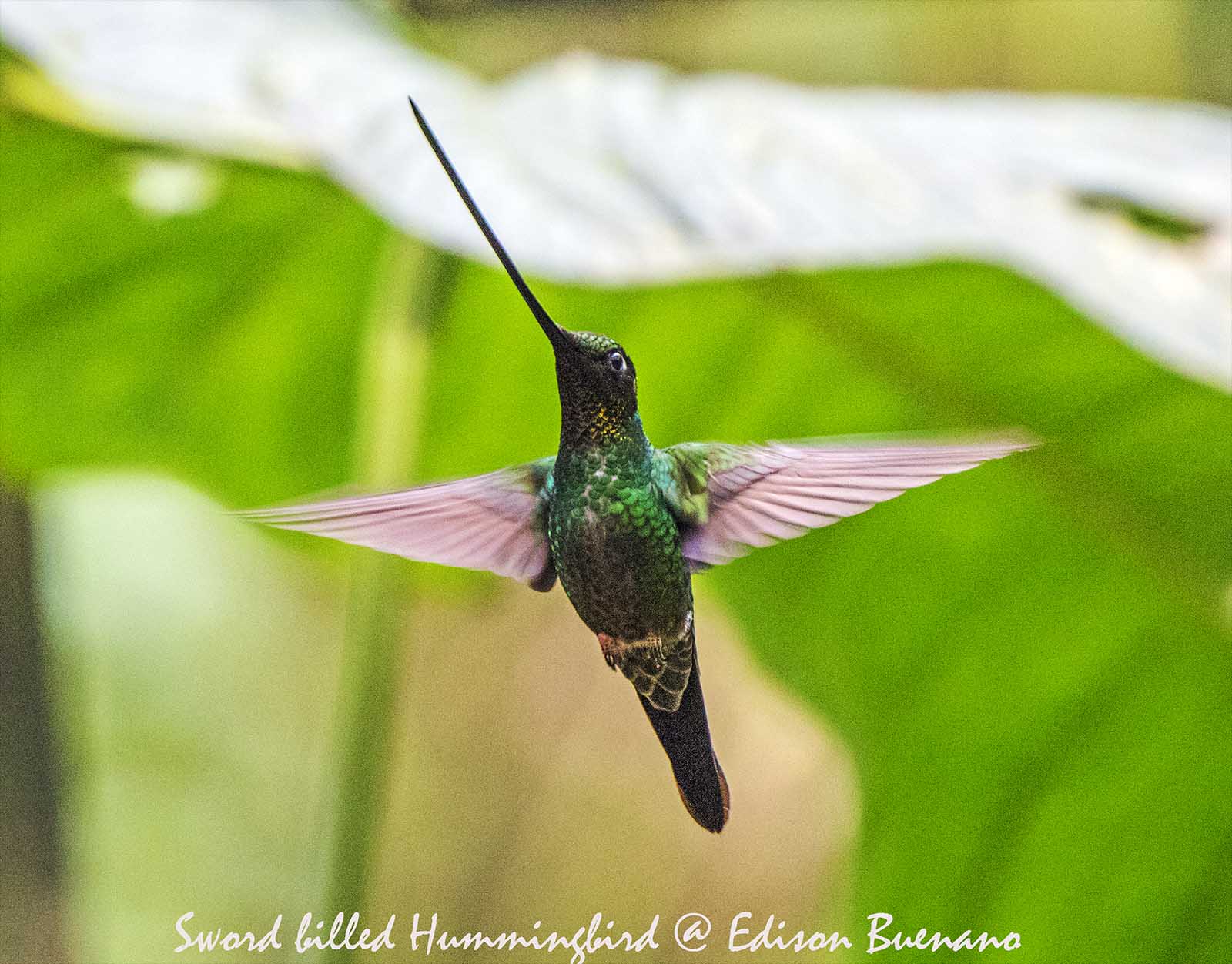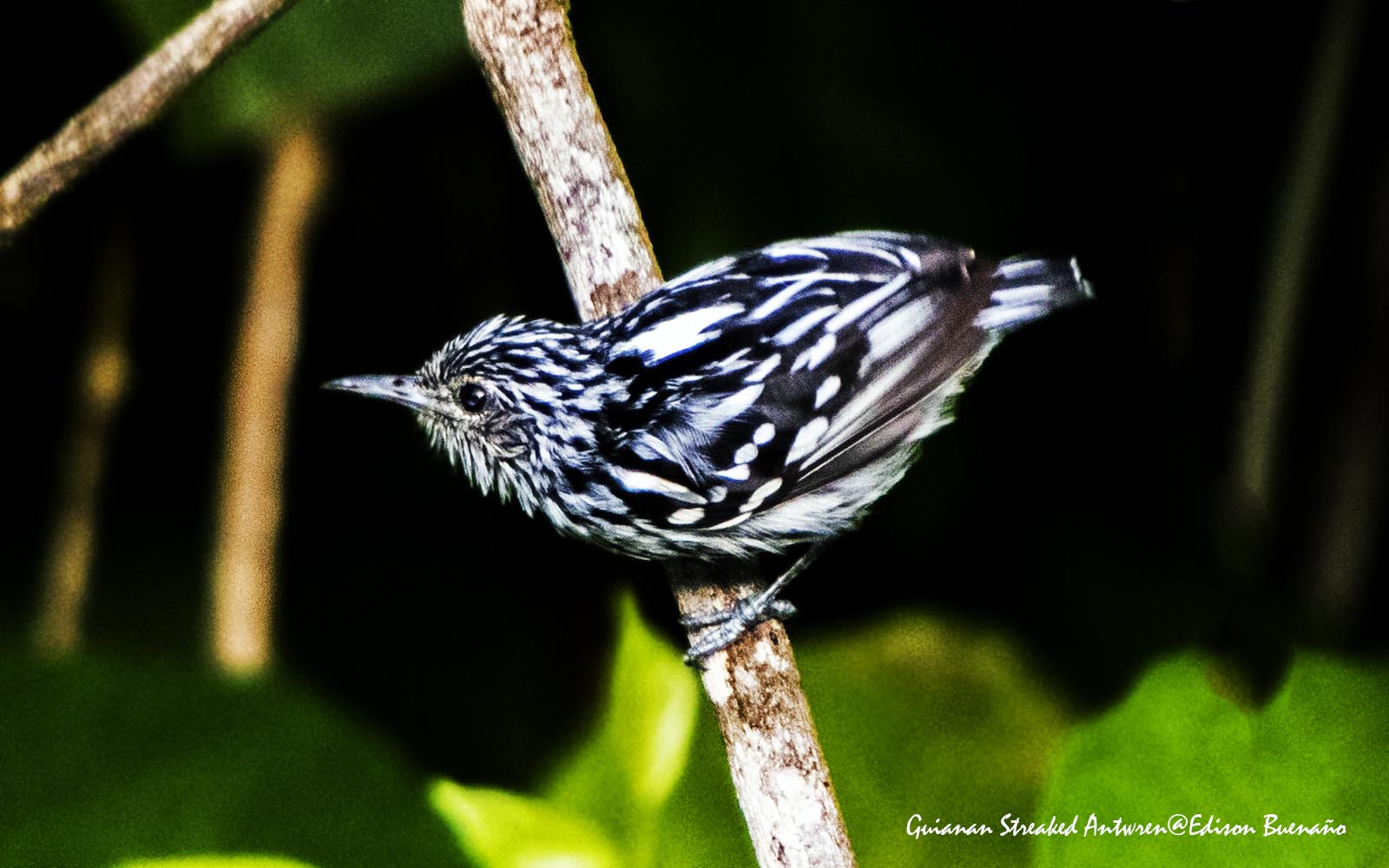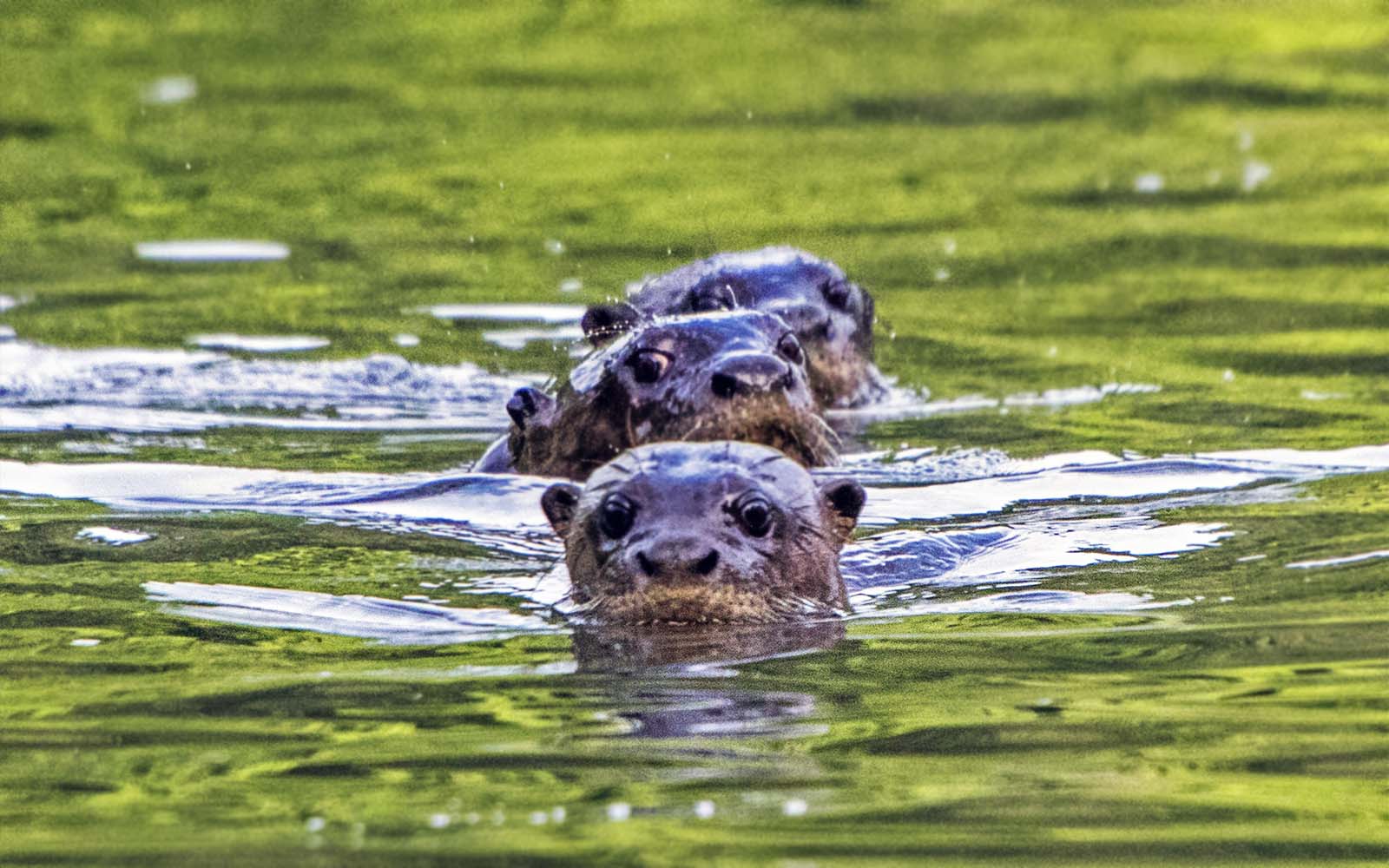PARTICIPANTS
Pan Jordan
Janie Iverson
Peggy Page
GUIDE : EDISON BUENAÑO
We are a party of three birding friends (Pam Jordan, Janie Iverson and Peggy Page) from Maine. In our third trip in as many years with our friend and guide Edison Buenaño , we totaled 540 species in fifteen days of birding, and built our country list for Ecuador past 900. (There were also 28 species heard but not seen). Edison had put together an excellent itinerary that brought us to a variety of habitats at several elevations. In a two-part journey centered in Quito, the first half took us from the paramo of the High Andes at Antisana to the Amazonian lowlands; in the second half, we passed over the western slope and up into the humid northwest of Esmeraldas province. This trip report was written by Peggy.
Day 1: Antisana and the paramo
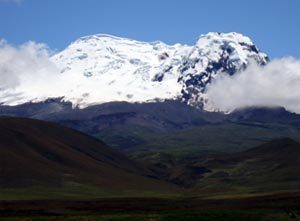 An early start from our hotel in Quito brought us to the borders of Antisana National Park before the day began to warm. In the rolling pasturelands, our first new bird of the day was a Giant Hummingbird perched on a wire, hunting insects with un-hummerlike floppy flight. On a nearby bare tree, a Black-tailed Trainbearer sat quietly, its long streamer tail stiffened in the steady breeze. Further along the road, we stopped on a small bridge over a stream to watch Ecuadorian Hillstars whiz about, and had nice looks at a very active Tufted Tit-tyrant and an Andean Tit-spinetail in the thickets. In the grasslands, Andean Siskins and a Streak-backed Canastero were spotted. As the elevation increased, we began to see most of the typical birds of the paramo, including both Bar-winged and Stout-billed Cinclodes, Paramo Pipit, and Plumbeous Sierra-finch. The plains stretching out at the very base of Volcane Antisana hosted a large flock of gorgeous Andean Gulls, numerous Black-faced Ibis and many strolling and soaring Carunculated Caracara. Edison amazed us by spotting two well-hidden juvenile Andean Lapwing. But the biggest thrills of the day were provided by a total of six Andean Condors, including a pair which soared through our field of vision right across the snowy face of the volcano. Lake La Mica, a high elevation reservoir for the city of Quito, hosted Silvery Grebe, Andean Teal, Andean Coot and Andean Ruddy Duck. The end of the day brought us back through Papallacta Pass, with a brief stop near a rose plantation for Green Trainbearer and Blue-and-Yellow Tanagers. Night at Termas Papallacta, where we enjoyed a long soak in the thermal pool right at our cabin door, and celebrated Pam’s birthday in the excellent restaurant.
An early start from our hotel in Quito brought us to the borders of Antisana National Park before the day began to warm. In the rolling pasturelands, our first new bird of the day was a Giant Hummingbird perched on a wire, hunting insects with un-hummerlike floppy flight. On a nearby bare tree, a Black-tailed Trainbearer sat quietly, its long streamer tail stiffened in the steady breeze. Further along the road, we stopped on a small bridge over a stream to watch Ecuadorian Hillstars whiz about, and had nice looks at a very active Tufted Tit-tyrant and an Andean Tit-spinetail in the thickets. In the grasslands, Andean Siskins and a Streak-backed Canastero were spotted. As the elevation increased, we began to see most of the typical birds of the paramo, including both Bar-winged and Stout-billed Cinclodes, Paramo Pipit, and Plumbeous Sierra-finch. The plains stretching out at the very base of Volcane Antisana hosted a large flock of gorgeous Andean Gulls, numerous Black-faced Ibis and many strolling and soaring Carunculated Caracara. Edison amazed us by spotting two well-hidden juvenile Andean Lapwing. But the biggest thrills of the day were provided by a total of six Andean Condors, including a pair which soared through our field of vision right across the snowy face of the volcano. Lake La Mica, a high elevation reservoir for the city of Quito, hosted Silvery Grebe, Andean Teal, Andean Coot and Andean Ruddy Duck. The end of the day brought us back through Papallacta Pass, with a brief stop near a rose plantation for Green Trainbearer and Blue-and-Yellow Tanagers. Night at Termas Papallacta, where we enjoyed a long soak in the thermal pool right at our cabin door, and celebrated Pam’s birthday in the excellent restaurant.
Day 2: Papallacta Pass
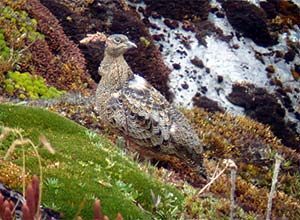 Our early morning birding took us into the hilly reserve owned by our lodge, where highlights included a mating pair of Andean Pygmy-owls and a couple of lively mixed flocks. After breakfast, we headed up to a mountain summit in the Cayambe Coca Reserve, hoping to find Rufous-bellied Seedsnipe among the communications antennas at the top. On the way up, we had close roadside looks at a Tawny Antpitta calling from atop a bush in very un-antpitta-like display, as well as several Paramo Ground-tyrant. Two hours of painstaking scanning at the summit, however, did not turn up the seedsnipes. After lunch, we headed for the spectacular hummingbird feeders of lovely Guango Lodge, where we tallied fifteen hummer species over the next two days, including Gorgeted and White-bellied Woodstars and close looks at perched and feeding Sword-bills. The numerous Tourmaline Sunangels allowed close approach and would sit to feed on my finger when I held it near a feeder. These feeders are a photographer’s dream. We closed the day by birding along the meadow behind the lodge, watching Torrent Ducks and White-capped Dippers on the nearby Papallacta River. We spent the night at the charming Guango Lodge.
Our early morning birding took us into the hilly reserve owned by our lodge, where highlights included a mating pair of Andean Pygmy-owls and a couple of lively mixed flocks. After breakfast, we headed up to a mountain summit in the Cayambe Coca Reserve, hoping to find Rufous-bellied Seedsnipe among the communications antennas at the top. On the way up, we had close roadside looks at a Tawny Antpitta calling from atop a bush in very un-antpitta-like display, as well as several Paramo Ground-tyrant. Two hours of painstaking scanning at the summit, however, did not turn up the seedsnipes. After lunch, we headed for the spectacular hummingbird feeders of lovely Guango Lodge, where we tallied fifteen hummer species over the next two days, including Gorgeted and White-bellied Woodstars and close looks at perched and feeding Sword-bills. The numerous Tourmaline Sunangels allowed close approach and would sit to feed on my finger when I held it near a feeder. These feeders are a photographer’s dream. We closed the day by birding along the meadow behind the lodge, watching Torrent Ducks and White-capped Dippers on the nearby Papallacta River. We spent the night at the charming Guango Lodge.
Day 3: Guango Lodge and The Antennas
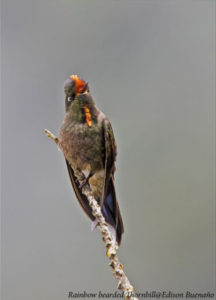 Today began with a ritual that is becoming increasingly familiar at many sites in Ecuador – the ceremonial feeding of the local antpitta. Here at Guango, it is “Panchita”, a shy Chestnut-crowned Antpitta who is coaxed into the open only a few meters from the main road for her breakfast of chopped worms and then quickly disappears back into the forest, from which she continues to call plaintively. Then, a lovely and productive morning again in the grounds of the Lodge, where mixed flocks and a huge variety of birds kept us very busy. Highlights were close encounters with an Andean Guan, great looks at a pair of feeding Cinnamon Flycatchers and flocks that included Cinerous and Blue-backed Conebills, Mountain Wren, Pearled Treerunner, Streaked Tufted-cheek and numerous Blackburnian Warblers. Pale-naped and Slaty Brush-finch called from the low thickets, and a small band of Gray-breasted Mountain Toucans appeared in the tall trees beside the road. Patience also paid off with close looks at Azara and Rufous Spinetails and very active Black-eared Hemispingus. A quick visit back to the river before lunch gave us closer looks at a pair of Torrent Ducks, as well as a pair of dippers busily working on lining a nest hole in the river bank. In the afternoon, we returned to the Antennas and almost immediately spotted two beautiful Rufous-bellied Seed-snipe foraging among the tightly packed paramo plants. The elevation (about 4500 meters) here combines with the view to literally take your breath away. That afternoon, we continued East and downslope to San Isidro Lodge, home of the famous “Mystery Owl” whose species has not yet been decided by ornithologists. Is it a hybrid of Black-and-white/Band-bellied or a new species? We had great flashlight views of this large and eerie owl, with its tight black banding and brilliant red eyes. Night at the very comfortable San Isidro lodge.
Today began with a ritual that is becoming increasingly familiar at many sites in Ecuador – the ceremonial feeding of the local antpitta. Here at Guango, it is “Panchita”, a shy Chestnut-crowned Antpitta who is coaxed into the open only a few meters from the main road for her breakfast of chopped worms and then quickly disappears back into the forest, from which she continues to call plaintively. Then, a lovely and productive morning again in the grounds of the Lodge, where mixed flocks and a huge variety of birds kept us very busy. Highlights were close encounters with an Andean Guan, great looks at a pair of feeding Cinnamon Flycatchers and flocks that included Cinerous and Blue-backed Conebills, Mountain Wren, Pearled Treerunner, Streaked Tufted-cheek and numerous Blackburnian Warblers. Pale-naped and Slaty Brush-finch called from the low thickets, and a small band of Gray-breasted Mountain Toucans appeared in the tall trees beside the road. Patience also paid off with close looks at Azara and Rufous Spinetails and very active Black-eared Hemispingus. A quick visit back to the river before lunch gave us closer looks at a pair of Torrent Ducks, as well as a pair of dippers busily working on lining a nest hole in the river bank. In the afternoon, we returned to the Antennas and almost immediately spotted two beautiful Rufous-bellied Seed-snipe foraging among the tightly packed paramo plants. The elevation (about 4500 meters) here combines with the view to literally take your breath away. That afternoon, we continued East and downslope to San Isidro Lodge, home of the famous “Mystery Owl” whose species has not yet been decided by ornithologists. Is it a hybrid of Black-and-white/Band-bellied or a new species? We had great flashlight views of this large and eerie owl, with its tight black banding and brilliant red eyes. Night at the very comfortable San Isidro lodge.
Day 4: San Isidro Lodge
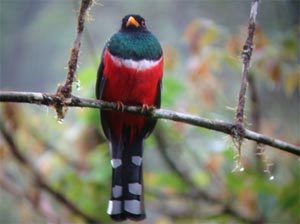 Even the trees around the dining room provide great morning birding at San Isidro, starting with a fly-in by a Highland Motmot, a species we had searched for and missed last year in the South. An almost tame pair of Masked Trogons also sat in the garden trees, as well as Barred Becard, Black-billed Peppershrike and a gorgeous Fawn-breasted Tanager. A hormone-addled pair of Flame-faced Tanagers repeatedly attacked the windows of a lodge building, while we enjoyed visiting with some of the “home” birds, including Canada and Blackburnian Warblers and a quiet Swainson’s Thrush. We also made the acquaintance of one of the two lodge antpittas, this one a White-bellied who comes to the calls and whistles of a lodge employee for his morning worms. The other, a Chestnut-crowned, was apparently out of town that day. A day spent birding along the road gave us both Crested and Golden-headed Quetzal, perched opposite each other on either side of the road, and many exciting mixed flocks. Mixed flocks, as always, rewarded the hours of watchful walking. San Isidro is a very comfortable and birdy lodge, with excellent food – including their delightful black pepper ice cream.
Even the trees around the dining room provide great morning birding at San Isidro, starting with a fly-in by a Highland Motmot, a species we had searched for and missed last year in the South. An almost tame pair of Masked Trogons also sat in the garden trees, as well as Barred Becard, Black-billed Peppershrike and a gorgeous Fawn-breasted Tanager. A hormone-addled pair of Flame-faced Tanagers repeatedly attacked the windows of a lodge building, while we enjoyed visiting with some of the “home” birds, including Canada and Blackburnian Warblers and a quiet Swainson’s Thrush. We also made the acquaintance of one of the two lodge antpittas, this one a White-bellied who comes to the calls and whistles of a lodge employee for his morning worms. The other, a Chestnut-crowned, was apparently out of town that day. A day spent birding along the road gave us both Crested and Golden-headed Quetzal, perched opposite each other on either side of the road, and many exciting mixed flocks. Mixed flocks, as always, rewarded the hours of watchful walking. San Isidro is a very comfortable and birdy lodge, with excellent food – including their delightful black pepper ice cream.
Day 5: Guaycamayos Ridge and the Loreto Road
We spent a misty morning on the ridge trail at Guaycamayos Ridge, part of the Antisana National Park and home to many uncommon and exciting birds. At the very start of the trail, Edison called out a reluctant little Sepia-Brown Wren (sometimes called Sharpe’s Wren) and, in the bamboo, an even more reluctant Flammulated Treehunter, who gave us frustratingly brief looks. One of the highlights of the morning was a chance to glimpse a pair of Greater Scythebills as they quickly worked their way up a densely wooded hillside and out of sight. Calling Black-billed Mountain Toucans were finally spotted in the fog, and we had a good look at a high Dusky Piha. As usual, long periods of listening and searching were punctuated by frantic identification of mixed flocks. In the afternoon, we again headed east, this time along the Loreto Road toward Wildsumaco Lodge. Along the way, we spent almost an hour admiring the constantly changing avian customers at a fruiting roadside rubiacia tree. It attracted ten different tanager species, giving us amazing eye-levels views of Paradise, Golden-eared, Orange-eared, Spotted and Golden among others. Sooty-headed and Golden-faced Tyranullets, a pair of Masked Tityra, a Smoky-brown Woodpecker and Dusky Spinetail also visited, while across the road, I had the best view of a Cerulean Warbler one could ever hope for – at eye level. How amazing to see that they really are blue! Further along the road, Edison spotted what at first appeared to be a Many-banded Aracari in a farmyard sapling. There were many bands, all right, but they were one-each on a pair of Chestnut-eared Aracaris who were mating! Our final birding of the day, as the light began to fail, was at the feeders close to Wildsumaco Lodge. Hummingbirds there included Napo Sabrewing, Golden-tailed Sapphire, Booted Racket-tail (the eastern variety, with buffy instead of white pufflegs like their western counterparts), Gould’s Jewelfront, Violet-fronted Brilliant and Many-spotted. A little owling that night turned up a beautiful Band-bellied Owl, but we were unable to lure in a Foothills Screech-owl, which called but kept its distance.
Day 6: The trails at Wildsumaco
 Wildsumaco is on the eastern slope, at about 1700 meters. Its steep, heavily wooded trails offer excellent birding, as does the road to the lodge. We began the day on the Piha Trail, where in a grove of small trees with a high canopy, we had great views of a Coppery-chested Jacamar, another of the species we had searched for unsuccessfully in the south in 2008. Gray-tailed Piha and a briefly perched Barred Forest Falcon were exciting, as were the many toucans at the bottom of the trail, where a stream cut through the forest. Chestnut-tipped Toucanet, Many-banded Araçari, Channel-billed and Black-mandibled Toucans were all present there. The afternoon was spent on the muddy Lariisoma Trail, where we spotted a Buff-tailed Sicklebill at the heliconia and had excellent looks at a beautiful White-backed Fire-eye in the thicket. In the open canopy of a huge tree, we spotted both Summer and Scarlet Tanagers and some of us got a glimpse of a Rose-breasted Grosbeak, all of them making their plans to visit us next month in New England, we hope. From the road on our walk back to the lodge, we spotted a large flock of Chestnut-fronted Macaws, as well as Maroon-tailed Parakeets. A Lineated Woodpecker worked the trees beside fields where Social Flycatchers and several seedeaters were feeding. White-thighed and Blue-and-white Swallows graced the wires.
Wildsumaco is on the eastern slope, at about 1700 meters. Its steep, heavily wooded trails offer excellent birding, as does the road to the lodge. We began the day on the Piha Trail, where in a grove of small trees with a high canopy, we had great views of a Coppery-chested Jacamar, another of the species we had searched for unsuccessfully in the south in 2008. Gray-tailed Piha and a briefly perched Barred Forest Falcon were exciting, as were the many toucans at the bottom of the trail, where a stream cut through the forest. Chestnut-tipped Toucanet, Many-banded Araçari, Channel-billed and Black-mandibled Toucans were all present there. The afternoon was spent on the muddy Lariisoma Trail, where we spotted a Buff-tailed Sicklebill at the heliconia and had excellent looks at a beautiful White-backed Fire-eye in the thicket. In the open canopy of a huge tree, we spotted both Summer and Scarlet Tanagers and some of us got a glimpse of a Rose-breasted Grosbeak, all of them making their plans to visit us next month in New England, we hope. From the road on our walk back to the lodge, we spotted a large flock of Chestnut-fronted Macaws, as well as Maroon-tailed Parakeets. A Lineated Woodpecker worked the trees beside fields where Social Flycatchers and several seedeaters were feeding. White-thighed and Blue-and-white Swallows graced the wires.
Day 7: Wildsumaco and on to the Lowlands
A rainy morning kept the trails dark and quiet, but we did manage to spot Ecuadorian Piedtail and Wedge-billed Hummingbirds, as well as Pale-tailed Barbthroat along the trail. We were able to find an Amazonian White-tailed Trogon we had tried to call out the previous day, and got fleeting but acceptable looks at a skulking Plain-backed Antpitta. During a last visit to the hummingbird feeders, we heard the beautiful calls of a Musician Wren and were able to locate it at the forest edge. This must be one of the most exquisite songs in the avian world, clear and melodious – almost a human “tune”. In the afternoon, we headed down into the Amazonian lowlands across the Napo River, where we arrived at the rustic Gareno Lodge with just enough light left to clearly see the three Fiery Topaz pointed out by the local guide, and a pair of roosting Crested Owls. From the road, the path down to the lodge is a steep and slick endurance course, complete with one-by-one rustic suspension bridge over the river!
Day 8: Gareno Lodge in the Amazonian Lowlands
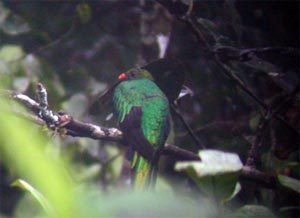 Gareno is a rustic lodge in the land of the local Huaorani people. Though there is no electricity, the cabins are very comfortable and the food is excellent. Edison was assisted here by Sandro, one of the local guides. On our first morning, we woke to heavy rain and delayed setting off from the communal dining area until it let up. However, we were happy to spend time there with Monga, a local Huaorani man who showed us how he stripped fibers from a palm and fashioned them into darts, wadding cotton on the edges for ballast. With Edison translating, he told us some fascinating stories about his own life and that of his people, and leafed through a dilapidated volume of photos of Huaorani people to add to his tales. Once the rain let up, we headed out to find the Rufous Potoo who roosts in the nearby forest, and Sandro soon located it for us. Again, the trails were very steep and the red mud treacherously slick. But the birds – once we found them – were excellent. The highlight of the morning was an amazing phenomenon that neither Edison or Sandro had even seen, or even heard of – an “ant swarm in the sky”. Birders in the tropics eagerly seek out ant swarms on the forest floor, for the hordes of hungry birds they attract. In this case, we discovered a swarm of flying termites massed around a large nest about ten meters from the ground, and the canopy around it was just as full of birds as if it had been on the ground. Six species of antwren (Gray, Rufous-tailed, Long-winged, White-flanked, Yasuni and Plain-winged) were joined by Dusky-throated Ant-shrike, Screaming Piha, Dusky-tailed Flatbill and three thrushes (Swainson’s, Lawrence’s and White-necked). Buff-throated and Olive-backed Woodcreepers took their share, too. We could hardly keep up as Edison called out the species as they flew in and out of the swarm. Later, along the trail, we added Sooty Antbird. In a clearing with a good view of the forest edge, we spotted Black-bellied Cuckoo, Amazonian White-tailed Trogon, White-fronted Nunbird, Golden-headed Manakin and a preening White Hawk. The rain returned in the afternoon, and our only interesting sighting was a Spix’s Guan, a bird perhaps in decline in the area due to Huaorani hunting. Unfortunately, the Harpy Eagles for which Gareno has become famous are not currently nesting and had disappeared into the vast forest. Nor were the local Ornate Hawk-eagled willing to come out in the rain.
Gareno is a rustic lodge in the land of the local Huaorani people. Though there is no electricity, the cabins are very comfortable and the food is excellent. Edison was assisted here by Sandro, one of the local guides. On our first morning, we woke to heavy rain and delayed setting off from the communal dining area until it let up. However, we were happy to spend time there with Monga, a local Huaorani man who showed us how he stripped fibers from a palm and fashioned them into darts, wadding cotton on the edges for ballast. With Edison translating, he told us some fascinating stories about his own life and that of his people, and leafed through a dilapidated volume of photos of Huaorani people to add to his tales. Once the rain let up, we headed out to find the Rufous Potoo who roosts in the nearby forest, and Sandro soon located it for us. Again, the trails were very steep and the red mud treacherously slick. But the birds – once we found them – were excellent. The highlight of the morning was an amazing phenomenon that neither Edison or Sandro had even seen, or even heard of – an “ant swarm in the sky”. Birders in the tropics eagerly seek out ant swarms on the forest floor, for the hordes of hungry birds they attract. In this case, we discovered a swarm of flying termites massed around a large nest about ten meters from the ground, and the canopy around it was just as full of birds as if it had been on the ground. Six species of antwren (Gray, Rufous-tailed, Long-winged, White-flanked, Yasuni and Plain-winged) were joined by Dusky-throated Ant-shrike, Screaming Piha, Dusky-tailed Flatbill and three thrushes (Swainson’s, Lawrence’s and White-necked). Buff-throated and Olive-backed Woodcreepers took their share, too. We could hardly keep up as Edison called out the species as they flew in and out of the swarm. Later, along the trail, we added Sooty Antbird. In a clearing with a good view of the forest edge, we spotted Black-bellied Cuckoo, Amazonian White-tailed Trogon, White-fronted Nunbird, Golden-headed Manakin and a preening White Hawk. The rain returned in the afternoon, and our only interesting sighting was a Spix’s Guan, a bird perhaps in decline in the area due to Huaorani hunting. Unfortunately, the Harpy Eagles for which Gareno has become famous are not currently nesting and had disappeared into the vast forest. Nor were the local Ornate Hawk-eagled willing to come out in the rain.
Day 9: Gareno and back to Quito
Morning birding along the road tried our patience as we spent over an hour – successfully – calling in a Pavonine Quetzal. Edison and Sandro never gave up on bringing this bird in! As we waited, Pam and Janie and I amused ourselves watching a mixed flock of incredible variety, a stolid Ferruginous Pygmy-owl at its center. Swallow-tail Puffbird, Yellow-tufted Woodpecker, Black-eared Fairy, Mottle-backed Elaenia, Plum-throated Cotinga, White-vented and Rufous-bellied Euphonia, Green Honeycreeper and several tanagers flew into and around the trees where the owl sat. White-throated Toucan and Purple-throated Fruitcrow made guest appearances. Shortly after we finally got close and excellent views of the Quetzal, a White-tailed Trogon landed, calling, a few feet from it. It rained almost constantly during our three days at Gareno, and though we had a good variety of birds, numbers were somewhat low and raptors mostly absent. But, as we all agreed, “that’s birding!”. The five hour drive back to Quito was pleasant and turned up the occasional interesting roadside bird.
Day 10: The Oilbird Farm and Mindo
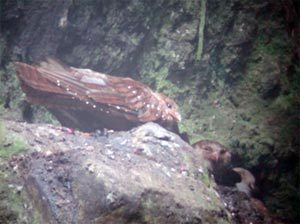 We headed out early once again from Quito, this time in the opposite direction toward the western slopes. We were headed for a reliable site for oilbirds deep in the countryside. Along the way, we stopped along the road for mixed flocks, encountering one especially productive group on a grassy wooded slope. White-throated Crake called from the wet grass only a few meters away, but we were able to catch only the most fleeting glimpse. On a bare branch above, a wet female Golden-headed Quetzal sat with her wings and tail spread, drying her feathers and ignoring us. A number of flycatchers were working the area, including Rusty-margined and Bran-colored, and we had great looks at Red-faced and Slaty Spinetails. Our destination was a working farm and Cueva de los Tallos – Cave of the Oilbirds. Surprise: our transportation to the cave was a wagon pulled by a massive tractor! The fifteen minute ride through the incredibly lovely farm gave us a chance to admire both the scenery and the bird life. The oilbirds roost in a steep ravine, and the best views are from the streambed at the bottom of the ravine, accessed by (of course) a steep and muddy trail. There were several adults and three half-grown chicks nestled in the crevices, and we had excellent views (much better than previous looks Pam and I had had at Asa Wright in Trinidad). Hiking back up the trail, we encountered Rufous-tailed Jacamar, Pale-mandibled Araçari and Little Cuckoo, as well as numerous tanager flocks. A Striped Cuckoo chased insects in the road, oblivious to the approaching tractor wheels. Our wonderful morning was capped by a tour of the little museum assembled from artifacts collected by workers on the farm, including an amazing ceramic image of a bird god over a thousand years old. The sunny morning soon dissolved into rain, and our stops along the Old Mindo-Nono Road were quick and wet. One was at the home of Tony, an ex-pat American who maintains a dozen hummingbird feeders and estimates he feeds about three thousand hummers a day! Great views of the usual suspects of Mindo, including Booted Racket-tail, Violet-tailed Sylph, Andean Emerald, Purple-bibbed Whitetip, Brown and Collared Inca and a single Little Woodstar. A quick stop at Bella Vista, a popular inn, gave us Gorgeted Sunangel at the feeders and White-throated Quail-Dove at the compost pile. Spillman’s and Ocellated Tapaculo called nearby but could not be tempted out onto the wet trail. We arrived at the beautiful Septimo Paraiso inn with just enough light left to enjoy their very busy feeders as well.
We headed out early once again from Quito, this time in the opposite direction toward the western slopes. We were headed for a reliable site for oilbirds deep in the countryside. Along the way, we stopped along the road for mixed flocks, encountering one especially productive group on a grassy wooded slope. White-throated Crake called from the wet grass only a few meters away, but we were able to catch only the most fleeting glimpse. On a bare branch above, a wet female Golden-headed Quetzal sat with her wings and tail spread, drying her feathers and ignoring us. A number of flycatchers were working the area, including Rusty-margined and Bran-colored, and we had great looks at Red-faced and Slaty Spinetails. Our destination was a working farm and Cueva de los Tallos – Cave of the Oilbirds. Surprise: our transportation to the cave was a wagon pulled by a massive tractor! The fifteen minute ride through the incredibly lovely farm gave us a chance to admire both the scenery and the bird life. The oilbirds roost in a steep ravine, and the best views are from the streambed at the bottom of the ravine, accessed by (of course) a steep and muddy trail. There were several adults and three half-grown chicks nestled in the crevices, and we had excellent views (much better than previous looks Pam and I had had at Asa Wright in Trinidad). Hiking back up the trail, we encountered Rufous-tailed Jacamar, Pale-mandibled Araçari and Little Cuckoo, as well as numerous tanager flocks. A Striped Cuckoo chased insects in the road, oblivious to the approaching tractor wheels. Our wonderful morning was capped by a tour of the little museum assembled from artifacts collected by workers on the farm, including an amazing ceramic image of a bird god over a thousand years old. The sunny morning soon dissolved into rain, and our stops along the Old Mindo-Nono Road were quick and wet. One was at the home of Tony, an ex-pat American who maintains a dozen hummingbird feeders and estimates he feeds about three thousand hummers a day! Great views of the usual suspects of Mindo, including Booted Racket-tail, Violet-tailed Sylph, Andean Emerald, Purple-bibbed Whitetip, Brown and Collared Inca and a single Little Woodstar. A quick stop at Bella Vista, a popular inn, gave us Gorgeted Sunangel at the feeders and White-throated Quail-Dove at the compost pile. Spillman’s and Ocellated Tapaculo called nearby but could not be tempted out onto the wet trail. We arrived at the beautiful Septimo Paraiso inn with just enough light left to enjoy their very busy feeders as well.
Day 11: Angel Paz, Milpe Road and the drive to Rio Canandé
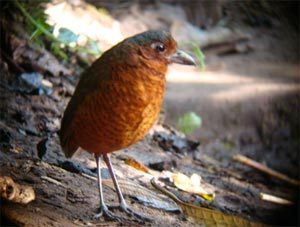 Of course, no visit to Ecuador is complete without a morning spent with Angel Paz, the local farmer who has famously habituated antpittas to his voice and lures them out with mealy worms. It was still dark when we (and a LOT of other people, we were sorry to see) reached the bottom of his trails to see Andean Cock-of-the-Rock calling in their lek. Since our last visit two years ago, Angel has added a fruit feeding station which on that day attracted a couple of Sickle-winged Guans. We also had good looks close by at Toucan Barbet and Olivaceous Piha, but the star attractions are the antpittas. Maria, Angel’s renowned Giant Antpitta, had been out of town on our last visit, but this time, with some coaxing by Angel and his brother, we had a good look at Maria’s companion Cariňo as he cautiously snatched up the proffered worms and scurried back into the forest. Maria herself was just barely visible down the wooded slope, apparently on a nest. We headed back up the trail for the excellent breakfast that is part of this quirky excursion, passing up the Yellow-bellied and Mustached Antpittas we had seen on the last trip. Sometimes, beating the crowd to the food has its own rewards! The little pavilion where we ate offers a spectacular view, and a graceful Swallow-tailed Kite only enhanced it. After breakfast, we continued west, stopping briefly at Milpe Road to enjoy a large mixed flock that included Rufous-throated and Guira Tanagers, Scaly-throated Foliage Gleaner and several of “our” warblers, fattening up for the northern migration. The rest of the day was spent traveling, sometimes over terrible roads, into Esmeraldas Province and to the Jocotoco Foundation reserve at Rio Canandé, where we spent the next three day. Along the way, we passed through many fascinating villages and added some new birds to our trip list, including Orange-fronted Barbet, Masked Water-tyrant and Band-backed Wren. The highlight of the trip was our river-crossing – on a narrow wooden ferry, pushed by a dugout canoe powered by a small outboard motor! The feeders at Canande were busy with Purple-chested and Rufous-tailed Hummingbirds, and aggressive White-necked Jacobin. Right beside the cabins, a Rufous-tail has built a neat little, lichen-plasterednest, and we were able to peek at two very new, very naked chicks.
Of course, no visit to Ecuador is complete without a morning spent with Angel Paz, the local farmer who has famously habituated antpittas to his voice and lures them out with mealy worms. It was still dark when we (and a LOT of other people, we were sorry to see) reached the bottom of his trails to see Andean Cock-of-the-Rock calling in their lek. Since our last visit two years ago, Angel has added a fruit feeding station which on that day attracted a couple of Sickle-winged Guans. We also had good looks close by at Toucan Barbet and Olivaceous Piha, but the star attractions are the antpittas. Maria, Angel’s renowned Giant Antpitta, had been out of town on our last visit, but this time, with some coaxing by Angel and his brother, we had a good look at Maria’s companion Cariňo as he cautiously snatched up the proffered worms and scurried back into the forest. Maria herself was just barely visible down the wooded slope, apparently on a nest. We headed back up the trail for the excellent breakfast that is part of this quirky excursion, passing up the Yellow-bellied and Mustached Antpittas we had seen on the last trip. Sometimes, beating the crowd to the food has its own rewards! The little pavilion where we ate offers a spectacular view, and a graceful Swallow-tailed Kite only enhanced it. After breakfast, we continued west, stopping briefly at Milpe Road to enjoy a large mixed flock that included Rufous-throated and Guira Tanagers, Scaly-throated Foliage Gleaner and several of “our” warblers, fattening up for the northern migration. The rest of the day was spent traveling, sometimes over terrible roads, into Esmeraldas Province and to the Jocotoco Foundation reserve at Rio Canandé, where we spent the next three day. Along the way, we passed through many fascinating villages and added some new birds to our trip list, including Orange-fronted Barbet, Masked Water-tyrant and Band-backed Wren. The highlight of the trip was our river-crossing – on a narrow wooden ferry, pushed by a dugout canoe powered by a small outboard motor! The feeders at Canande were busy with Purple-chested and Rufous-tailed Hummingbirds, and aggressive White-necked Jacobin. Right beside the cabins, a Rufous-tail has built a neat little, lichen-plasterednest, and we were able to peek at two very new, very naked chicks.
Day 12: Canandé Reserve and the Votrosa Road
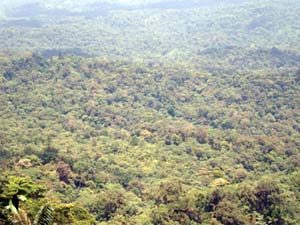 Heavy rain during the night (perhaps as much as a meter!) and threatening skies kept us off the trails; instead we birded along the reserve road and along Votrosa Road, used heavily by a local logging operation – and very birdy! Tanagers were everywhere: Scarlet breasted Dacnis, Tawny-crested, Golden-hooded, Emerald, Gray-and-Gold, Blue Whiskered, Scarlet-and-White, Lemon-spectacled, and the ever-present Lemon-rumped among others. In the course of a ten hour day, we added over sixty species to the trip list, including thirty-one lifers. The sun emerged soon after we started, and flycatchers were everywhere, including Western Sirystes and the easily approached Long-tailed Tyrant. Several Choco endemics made their appearances, including Choco Woodpecker, Choco Trogon and Scarlet-browed Tanager. Each stop revealed new birds. A Crested Guan sat in full view in a roadside tree, and ghostly white Black-tipped Cotingas were seen. Black-striped Woodcreepers and Dagua Thrush gave great looks. Northern Violaceous Trogons approached closely. I have to admit, though, that I am most likely to remember the five-foot long Green Snake that dropped onto the road from a tree twenty meters overhead, landing with a loud slap on the spot I had just vacated. Just his way of getting across the road! It was hot, humid birding but one of the most productive days we have ever had.
Heavy rain during the night (perhaps as much as a meter!) and threatening skies kept us off the trails; instead we birded along the reserve road and along Votrosa Road, used heavily by a local logging operation – and very birdy! Tanagers were everywhere: Scarlet breasted Dacnis, Tawny-crested, Golden-hooded, Emerald, Gray-and-Gold, Blue Whiskered, Scarlet-and-White, Lemon-spectacled, and the ever-present Lemon-rumped among others. In the course of a ten hour day, we added over sixty species to the trip list, including thirty-one lifers. The sun emerged soon after we started, and flycatchers were everywhere, including Western Sirystes and the easily approached Long-tailed Tyrant. Several Choco endemics made their appearances, including Choco Woodpecker, Choco Trogon and Scarlet-browed Tanager. Each stop revealed new birds. A Crested Guan sat in full view in a roadside tree, and ghostly white Black-tipped Cotingas were seen. Black-striped Woodcreepers and Dagua Thrush gave great looks. Northern Violaceous Trogons approached closely. I have to admit, though, that I am most likely to remember the five-foot long Green Snake that dropped onto the road from a tree twenty meters overhead, landing with a loud slap on the spot I had just vacated. Just his way of getting across the road! It was hot, humid birding but one of the most productive days we have ever had.
Days 13 and 14: The Trails of Canandé Reserve
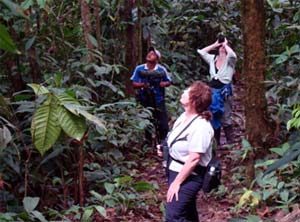 We spent the next day and a half prowling the steep and muddy trails of the reserve (are there any other kind in Ecuador?). Unfortunately, we were never able to locate the ant swarms that Edison sought; when present, swarming army ants attract large numbers of birds, especially antbirds, who feed frantically and pay no attention to birders. No, every bird we saw in these days was hard-won. A mid-story flock gave us a nice variety of antwrens, among them Checker-throated, White-flanked and Dot-winged. On both days, we had close views of pairs of massive Guayaquil Woodpeckers, in one case male and female on the same tree within inches of each other. High overhead, flocks of Golden-chested Tanagers made us crane to see them, and we spent thirty minutes peering into the dark vegetation until we all had decent looks at an elegant little Black-headed Antthrush as it called loudly from the ground. Another mixed flock gave us Lita Woodpecker, Lesser and Tawny-crowned Greenlet and Yellow-tufted Dacnis. Our climb took us to a high ridge overlooking the reserve, where fascinating insects entertained us as we ate our picnic lunch. Three nights at the lodge at Canandé, simple but very comfortable, but on the afternoon of Day 14, we headed back towards Mindo. Early on, we spotted a cruising Gray-headed Kite, who landed very obligingly on a post right next to the road. We spent the night at Septimo Paraiso, taking time before dinner to drive down into Mindo Town for a look at a roosting female Lyre-tailed Nightjar.
We spent the next day and a half prowling the steep and muddy trails of the reserve (are there any other kind in Ecuador?). Unfortunately, we were never able to locate the ant swarms that Edison sought; when present, swarming army ants attract large numbers of birds, especially antbirds, who feed frantically and pay no attention to birders. No, every bird we saw in these days was hard-won. A mid-story flock gave us a nice variety of antwrens, among them Checker-throated, White-flanked and Dot-winged. On both days, we had close views of pairs of massive Guayaquil Woodpeckers, in one case male and female on the same tree within inches of each other. High overhead, flocks of Golden-chested Tanagers made us crane to see them, and we spent thirty minutes peering into the dark vegetation until we all had decent looks at an elegant little Black-headed Antthrush as it called loudly from the ground. Another mixed flock gave us Lita Woodpecker, Lesser and Tawny-crowned Greenlet and Yellow-tufted Dacnis. Our climb took us to a high ridge overlooking the reserve, where fascinating insects entertained us as we ate our picnic lunch. Three nights at the lodge at Canandé, simple but very comfortable, but on the afternoon of Day 14, we headed back towards Mindo. Early on, we spotted a cruising Gray-headed Kite, who landed very obligingly on a post right next to the road. We spent the night at Septimo Paraiso, taking time before dinner to drive down into Mindo Town for a look at a roosting female Lyre-tailed Nightjar.
Day 15: Mindo and back to Quito
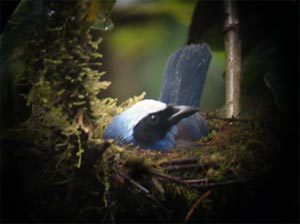 Our last full day in Ecuador dawned bright and sunny, and we headed out on the excellent trail behind the lodge. Almost immediately, we had great looks at a Long-tailed Antbird in the undergrowth. In a place where the trail looks out into the Snake Valley, we had quite a surprise – a perched Black-and-white Hawk-Eagle, the first record of this beautiful bird at Septimo. As it preened on an open branch, we were able to study and photograph it. Edison hurried back to the lodge for his scope in hope of getting even better photos, but of course the bird flew before he returned! The cool forest was full of birds, including White-winged Tanager, a racket-less Broad-billed Motmot and numerous other tanagers and flycatchers. A visit to the lodge’s fruit feeders gave us a leisurely look at one of the most gorgeous of tanagers – the lovely Fawn-breasted. The hummingbird feeders at Septimo Paraiso are crowded, and give birders a chance to really study many of the Mindo regulars. As we headed back to Quito, we made a last stop at La Pahuna Orchid Reserve, one of the most reliable spots for the orange-cheeked White-tailed Hillstar (nice views even in the rain, since they come often to the porch feeder). An added treat: we spent some time watching and photographing a female Beautiful Jay on the nest, and even watched as her mate came in and fed her lunch! We celebrated our incredible trip (and mourned our final night in Ecuador) at La Ronda, a Quito restaurant with great local food and wonderful local entertainment.
Our last full day in Ecuador dawned bright and sunny, and we headed out on the excellent trail behind the lodge. Almost immediately, we had great looks at a Long-tailed Antbird in the undergrowth. In a place where the trail looks out into the Snake Valley, we had quite a surprise – a perched Black-and-white Hawk-Eagle, the first record of this beautiful bird at Septimo. As it preened on an open branch, we were able to study and photograph it. Edison hurried back to the lodge for his scope in hope of getting even better photos, but of course the bird flew before he returned! The cool forest was full of birds, including White-winged Tanager, a racket-less Broad-billed Motmot and numerous other tanagers and flycatchers. A visit to the lodge’s fruit feeders gave us a leisurely look at one of the most gorgeous of tanagers – the lovely Fawn-breasted. The hummingbird feeders at Septimo Paraiso are crowded, and give birders a chance to really study many of the Mindo regulars. As we headed back to Quito, we made a last stop at La Pahuna Orchid Reserve, one of the most reliable spots for the orange-cheeked White-tailed Hillstar (nice views even in the rain, since they come often to the porch feeder). An added treat: we spent some time watching and photographing a female Beautiful Jay on the nest, and even watched as her mate came in and fed her lunch! We celebrated our incredible trip (and mourned our final night in Ecuador) at La Ronda, a Quito restaurant with great local food and wonderful local entertainment.
Our final tally – 540 species, plus the as-yet un-specified “Mystery Owl” of San Isidro. This surpassed even last year’s total in the very birdy south of Ecuador, and brought our total for the country to 906, almost all thanks to our dear friend Edison. A spectacular trip!
Ask for prices
Reserve Now Trip Report
For more information Contact Us!

